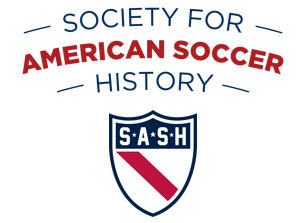Much of American soccer was in a doldrums in the first few years of the 20th century, resulting from a serious recession that had been sparked by the financial panic of 1893. This doesn’t seem to have bothered soccer in the midwest too badly, but in the east, the effects were severe. Both the American Football Association, the closest thing there was to a national governing body, and the National Association Foot Ball League, a New York-New Jersey league that was probably the best in the country, closed their doors in 1898. Those doors remained closed for about seven years. A very important factor in reopening them, and in reviving American interest in soccer, was the visits of an English amateur all-star team called the Pilgrims, who made American tours in 1905 and 1909.
Another English amateur team, the Corinthians, also made American tours, in 1906 and 1911, but it was the Pilgrims who had the greatest effect. The Corinthians made more of an impression in South America, where they are immortalized by the first-division team from Sao Paulo, Brazil, that carries their name to this day.
The Pilgrims tours were hailed enthusiastically by those Americans who were concerned about the violence in American football, where fatal injuries were not unknown. While the Pilgrims did not have the effect of replacing that sport with association football, they did give a boost to American soccer. The AFA Cup and the National Association Foot Ball League both resumed the year after the first Pilgrims visit. The Pilgrims also may have had something to do with the introduction of the English term “soccer” to America, as the use of that term here began around 1905.
College students had been among the most frequent American association football players in the earliest years of the sport in this country, in the late 1860s, but most of the schools that had been playing soccer abandoned it in 1876, turning to rugby (from which American football then was developed). The rebirth of American college soccer occurred in 1905 as a direct result of the first Pilgrims tour.
By the time of the Pilgrims tours, professional soccer already was firmly established in England, so the amateur Pilgrims were not a team of England’s best players. They were representatives of England’s upper-class amateur sports establishment and stated that their tours were aimed at demonstrating soccer as it was played in England and popularizing it in the United States. At the end of the 1905 tour, Pilgrims captain Fred Milne and forward Vivian Woodward visited Washington with the hope of meeting President Theodore Roosevelt for a discussion of their sport, but he was otherwise occupied.
The Pilgrims played 17 games (five of which were in Canada) on their 1905 tour and 23 games (all in the United States) on their 1909 tour. Those tours were particularly noteworthy for spending as much time in the midwest as they did.
The Pilgrims lost only one of their 12 United States games in 1905, against a Chicago all-star team. The other 11 games they won by a total of 72-7. The 1905 tour, which included stops in Detroit, St. Louis, Chicago, Philadelphia, Fall River, Boston and New York, lasted from Sept. 5 to Oct. 26. In St. Louis, a game between the Pilgrims and a St. Louis all-star team drew a crowd of 15,985 that was the largest in American soccer to that date.
The 1909 tour, from Oct. 2 to Nov. 16, visited most of the same locations, plus stops in Baltimore, Cincinnati, southern Illinois and several New Jersey cities. While the Pilgrims generally won with ease again in 1909, they were held to ties in two Illinois towns, Coal City and Gillespie, by local teams made up largely of British coal miners, and were beaten, 1-0 by Philadelphia Hibernians and, 2-1, in Massachusetts by the Fall River Rovers after drawing 1-1 with them the day before (the Rovers also beat the Corinthians). The Pilgrims did score big victories in 1909 over two other prominent American teams, beating Kearny Scots, 5-0, in New Jersey and St. Leo’s, 12-1, in St. Louis.
There have been many starts and stops, stumbles and recoveries, in the history of American soccer. The Pilgrims tours were definitely among the recoveries.
A version of this article first appeared on Roger’s Big Soccer blog on May 1, 2012.
